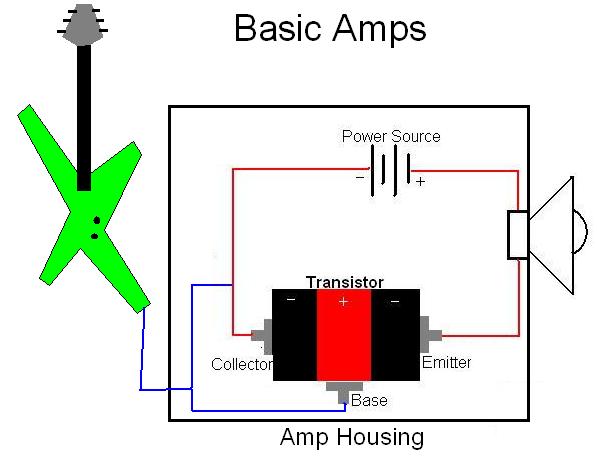| Amps |
| Amplifiers
or “Amps” are
used when using electric guitars to
increase the volume of the guitar so it can be heard easier. The sound is received by the pick-ups
located under the strings and electronic signals are sent to the amp so
the
sound can come out of the speakers. Transistors do most of the
work inside of amps; they are what
create a stronger electrical signal to send to the speaker. Basic transistors consist of three layers of
semiconductors and three nodes; the base, emitter and collector nodes. Two negatively charged layers of
semiconductors sandwich a layer of positively charged semiconductor. When there is no signal from the guitar, the
electrons fill in the positively charged gaps between the layers. This creates a neutral area preventing the
negatively charged electrons from passing through.
When current is sent to the base conductor from the
guitar, the
electrons flow into the transistor scattering the electrons that had
filled the
gaps. These gaps allow the electrons to
flow from the power source, through the layers, and to the speaker
recreating
the sound. If
the string on the guitar is plucked hard, it will send a
strong signal to the transistor recreating the sound louder than if it
was
plucked softly. When
a strong signal is sent
from the guitar then a lot of the electrons scatter inside the layers
allowing
a strong signal to be sent to the speaker. If
a weak signal is sent then less of the electrons
scatter inside the
layers allowing a weaker signal to the speaker.
The
next part inside the amp is the speaker. The speaker receives the
signal from the transistor (from the collector node) and turns it back
into sound waves. Speakers work in the opposite way that the
pick-ups do. The speaker uses a magnet and the electronic signals
to recreate the sound waves. The
signal flows through the green wires in the picture shown below.
As a signal is sent it creates a negative charge around the core
pushing it away from the magnet. As the core is pushed away from
the magnet it also pushes the cone. The cone is made out of a
light, flexible material so when the core pushes up the cone reacts in
the same way. As a series of signals are sent to the speaker it
causes the cone to vibrate causing a sound wave to radiate from the
speaker. As the sound waves leave the speaker they should arrive
at your ears shortly, then you can enjoy the musical presentation!
|
Background Image From: http://www.classicfirebird.com/tech/1967w.jpg |
